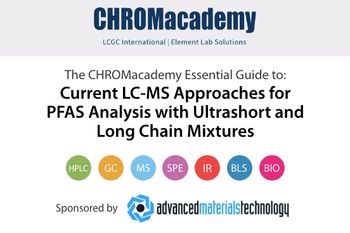
PFAS Determination in Matrices Beyond Water and Soil: Characterizing Exposure to this Important Class of Environmental Contaminants
Webinar Date/Time: Mon, Nov 18, 2024 11:00 AM EST
PFAS Toxicity Beyond Water and Soil: Discover new studies from brain and liver tissue.
Register Free:
Event Overview:
Per- and poly-fluoroalkyl substances (PFAS) are persistent chemicals commonly found in surface protectants and fire-fighting foams. Research has revealed that exposure to environmentally relevant concentrations of some PFAS can reduce reproductive success and have other adverse effects on animals. In this webinar, Professor Todd Anderson, from the Department of Environmental Toxicology, Texas Tech University, presents new findings from field studies determining PFAS concentrations in plant and animal tissues. His team have been involved in laboratory and field studies where it was necessary to determine PFAS concentrations in plant and animal tissues to (1) better understand the pathways of PFAS trophic transport from soil to higher organisms, and (2) to determine PFAS burdens in exposed organisms and the potential for maternal transfer of PFAS from adults to offspring.
LC-MS analytical methods for PFAS determination in water and soil matrices provide a solid foundation upon which to make slight changes to improve method performance for extracts of plant and animal tissues. In controlled laboratory studies with an avian model, we’ve used these modified methods with varying degrees of success, to measure PFAS in adult livers, eggs, hatchling livers, and brain tissue (adults and hatchings). These PFAS measurements in tissues allowed for determination of avian Toxicity Reference Values based on survival, growth, and reproduction endpoints, as well as maternal transfer from exposed adults to unexposed hatchlings. In field studies on historical fire training areas, we’ve used these modified methods on a limited set of PFAS analytes, to measure PFAS in vegetation, invertebrates, and small mammal livers. These PFAS measurements have allowed us to better understand the trophic transport pathway(s) from soil to higher organisms based on diet (herbivores, insectivores, omnivores) or activity (grooming, nest building).
Key Learning Objectives:
- Understand the pathways of PFAS trophic transport from soil to higher organisms
- Determine PFAS burdens in exposed organisms
- Estimate the potential for maternal transfer of PFAS from adults to offspring
Who Should Attend:
- Lab managers and researchers involved in PFAS analysis in food, clinical, environmental, and industrial field
- Researchers interested in expanding their PFAS analysis into the toxicological effects associated with PFAS exposure
Speakers:
Todd Anderson
Presidential Research Excellence Professor
Department of Environmental Toxicology, Texas Tech University
Todd Anderson is a Presidential Research Excellence Professor in the Department of Environmental Toxicology and The Institute of Environmental and Human Health (TIEHH) at Texas Tech University. His teaching and research focus on the movement and analysis of chemical contaminants (pollutants) in the environment. The ultimate objective is to evaluate and better characterize potential exposure of organisms to contaminants. An important set of supporting experiments involve specifically testing for the effects of selected chemicals using both invertebrate and vertebrate models. He received his M.S. and Ph.D. from the University of Tennessee, Knoxville under the direction of Barbara Walton at Oak Ridge National Laboratory (ORNL); he did postdoctoral research in pesticide toxicology and fate at Iowa State University with Joel Coats.
Richard Jack
Global Market Development Manager, Food and Environmental
Phenomenex
Richard Jack is the Global Market Development manager for the environmental and food markets at Phenomenex corporation. He has over 18 years of experience with chromatography and mass spectrometry for the environmental, food, cannabis, semiconductor, chemical, and pharmaceutical industries. Richard has collaborated with global regulatory agencies to develop validated methods through new applications, instrumentation, column chemistries, and software. He is a former EPA Scientific Advisor for the EPA’s panel on Hydraulic Fracturing, a coauthor for EPA 557 and 557.1 along with ASTM D8001 and updates to D4327 and D6919 methods. He is currently the Second Vice Chairman for the ASTM D19 subcommittee on water analysis. Previously Richard was a Vertical marketing manager with Thermo Fisher Scientific, Dionex, and Hitachi High Technologies where he designed analytical instrumentation, including IC and HPLC systems, pumps, autosamplers, and a variety of detectors. He received his Ph.D. in biochemistry and anaerobic microbiology from Virginia Tech University in Blacksburg, VA. He received his Master’s in ecology from the University of Tennessee in Knoxville, TN.
Register Free:
Newsletter
Join the global community of analytical scientists who trust LCGC for insights on the latest techniques, trends, and expert solutions in chromatography.





